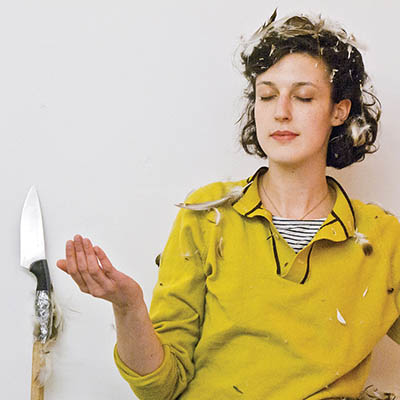Empathic spaces
New Genre Arts Festival restructures
Ayana Evans, featured New Genre artist
If you’ve seen Marina Abramović on YouTube, sitting at a table at the Museum of Modern Art and sharing a silent gaze with guests (around 1,500 of them, including her former lover), you’ve seen performance art.
Well, not quite. What you’ve seen is documentation of performance art. Probably you’ve been in your own space as you watched, your pause button under one finger, in control of a one-sided situation. The real thing is two-sided, immediate, personal; it requires you to be in the room with it.
Performance art can be unnerving, intense, hilarious, moving, subtle. It’s not quite theater, not quite dance or visual art or spoken word. It’s a live art practice in its own right, said Jessica Borusky, a performance artist and artistic director of Living Arts. Borusky is reconceptualizing and restructuring New Genre Arts Festival—in its 25th year as the organization’s flagship event—as an invitation to a human experience on a very human scale.
Instead of being spread between the gallery and the PAC over two weeks as they have been in the past, this year’s performances, installations, and educational events will all happen in the Living Arts space over the course of a single weekend.
The first performances will happen from 5–9 p.m. during First Friday on March 2, followed on Saturday from 1–3 p.m. with a panel discussion by the artists, then a different set of performances on Saturday evening. For those who want a hands-on experience, workshops led by artists Sichong Xie and Roz Crews will take place March 4. Thanks to a wide array of sponsors, every one of these events is free—a barrier-busting initiative launched under former director Steve Liggett in 2016.
The new format means a potent concentration of experiences chosen and orchestrated with both artists and audience in mind. A site map will be provided that tells who’s performing where and at what time.
“People can take their own pathway through,” Borusky said. “It’s not unlike how one might curate a sculptural show. There are about 25 national and international artists in total over the course of these two days, some back to back and some overlapping. You’re here for the whole time, but your understanding of time/space/body is a little bit different than in a theater where there are certain social expectations.”
 The restructuring encourages viewers to interact with artists outside of the performances as well.
The restructuring encourages viewers to interact with artists outside of the performances as well.
“It creates a porous third space between artists and audience,” Borusky said. “Come as you are. If that means you take a break and return, if you want to be quiet and reverent, if you want to chat with someone or talk to an artist—it’s all okay. It’s important that art asks us questions about ourselves and that we ask questions about art.”
A new element of this year’s festival is the Artist Engagement Dinner on March 1, where guests can talk more intimately with artists over a festival-inspired, family-style dinner created collaboratively by chefs from The Reserve at Grogg’s Green Barn, Amelia’s, and Red Thistle Catering Co., all within an analog sound and video installation by Austin, Texas artist Bug Davidson. (Tickets support the festival and are tax-deductible.)
“It’s really important for us as human beings to have brand-new experiences,” Borusky said. “Both for viewer involvement and for how Living Arts takes care of our local artists, it’s so important to see work you never thought was possible from artists you may never have gotten a chance to see before—and you don’t have to travel, and you don’t have to pay. We want people to just have direct access to the work.”
In a time when vulnerable bodies are coming forward in testimony and resistance, experiences of bearing witness, like those performance art delivers, are more critical than ever.
“This kind of art reminds us that we are all embodied, not only in that moment, but where our past bodies have been and where our future bodies can go,” Borusky said. “With performance art, especially when we have our audience not seated in the dark, we open a pathway to practicing empathy here in the gallery.
“There’s tons of bad performance art, bad dance, bad music. Just because it’s weird doesn’t mean it’s good, well thought-out, or critically engaged. I think the stuff that sticks is the stuff that engages vulnerability.”
You’ll find that at New Genre.
New Genre Arts Festival
Mar. 1–3 | Free
Living Arts of Tulsa | 307 E. M.B. Brady St.
livingarts.org/new-genre-art-festival


.jpg)
.jpg)
